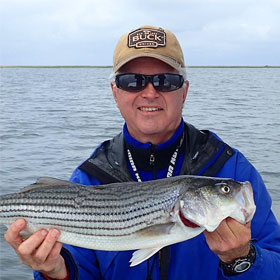Determining the Right Fly Fishing Rod Length for Beginners
By Ken Schultz
Mar 14, 2019
To determine the right fly fishing rod length for beginners, think first about your intended applications. Here are the factors you need to consider.
At a sport show recently I heard someone ask an exhibitor’s representative if she could recommend an appropriate fly fishing rod length for beginners. I didn’t stay to hear the reply, knowing that the answer would hinge on where you’ll be fishing, what species you’re after, what terminal gear you’ll be using, and so forth. If you don’t know those things in advance, determining the right fly rod length for beginners, indeed the right type of fly fishing outfit (rod-reel-line), is going to be tough. To address this, let’s first review what a fly rod does.
Fly Rod Characteristics
Fly tackle is different from other forms of fishing equipment (spinning, baitcasting, etc.) in that the principle involves the casting of a very light object (some type of fly) with a large-diameter heavy line. The rod is designed to build momentum during a cast to propel the fly with that heavy line to its intended target.
The reel seat on a fly rod is close to the butt, the guides are small, and length varies from 5 to 10 feet in general use, though special circumstances call for 12- to 14-foot or longer rods. Because fly lines are characterized by weight as opposed to breaking strength, fly rods are rated for casting a specific weight line. Thus, a 5-weight rod is designed for use with a 5-weight line, and a 8-weight rod is designed for use with an 8-weight line. Rod manufacturers design their rods (especially the stiffness and loading ability) to produce the best casting of a designated-weight line.
General Fly Fishing Rod Length for Beginners
It is mostly the case that a lighter-weight rod is shorter than a heavier weight rod, and that weight designation is generally more of a concern than is length. Determining the right fly fishing rod length for beginners is closely aligned with determining the right weight of rod for your intended applications.
If you’re fishing small streams for trout, you don’t need to cast very far, nor use really large flies, and you’‘ll be catching generally small fish, so a lighter weight rod and line, probably a 3- or 4-weight, would do the job. But if you’re intending to fish for largemouth bass, where bulky flies are necessary and fish may have to be muscled away from obstructions and cover, then an 8- or 9-weight rod would be required, especially if you’re a newcomer to flycasting. The 3-weight for trout would probably be about 7 or 7½ feet long, whereas the 9-weight for bass might be about 9 feet long.
Is There an All-Around Fly Fishing Rod Length for Beginners?
If you’re just getting started in fly fishing, you might be looking for one versatile outfit, something for all-around use. Honestly, that’s hard to come by. The 9-weight rod mentioned in the previous paragraph would be too long and stiff for casting in small streams and would overpower small fish. The 3-weight would not allow you to achieve distance or accuracy with large flies in bigger water. However, that’s not to say that they could only be used for the situations mentioned.
The 3-weight rod, for example, could also be used for casting small flies in ponds and the calmer sections of lakes. There, you could have a lot of fun with bluegills, shellcrackers, crappie, yellow perch, and maybe bullheads. The 9-weight rod is eminently feasible for other species than bass. It could also be used for northern pike, chain pickerel, and carp in freshwater, and for small to mid-sized specimens of coastal inshore species like striped bass, spotted seatrout, and redfish.
If you’re a beginning fly angler, think about where you’ll be fly fishing and what you’ll be pursuing. Then get your fishing license and head to a fly shop where knowledgeable personnel can help navigate the possibilities.









